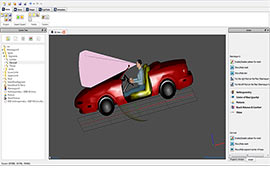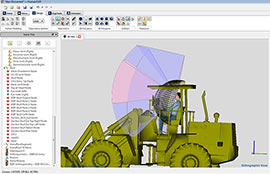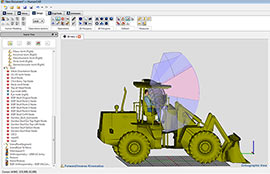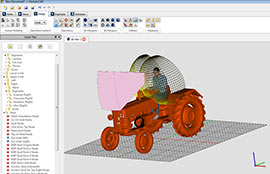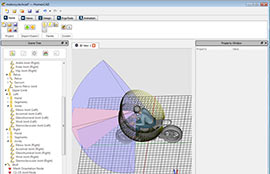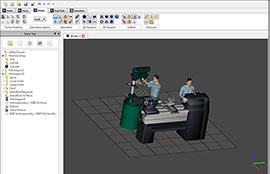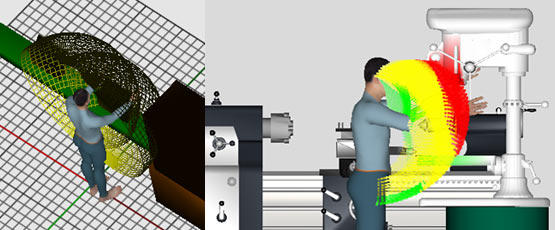HumanCAD®
NexGen Ergonomics' HumanCAD human modeling solution creates digital humans in a three-dimensional environment in which a variety of ergonomic and human factor analysis can be performed. HumanCAD aids users with the design of products and workplaces by determining what humans of different sizes can see, reach, or lift.
The new HumanCAD platform is our 5th generation and demonstrates our continued innovation that started in 1990 with ManneQuin, the world's first PC based human modeling solution and was followed by ManneQuinPRO and ManneQuinELITE. Thousands of users in various industries, government organizations, universities and consultants worldwide have acquired these human modeling solutions.
HumanCAD includes a modular architecture that allows customers to purchase the modules they need. Included in all configurations is inverse and forward kinematics, digital human creation using a variety of libraries and databases, vision and reach analysis and much more. You can save your custom postures or anthropometries in these libraries for reuse.
HumanCAD's ergonomic evaluation tools provide data on potential injury risk and postural analysis. Other human factor tools aid in the determination of reach, vision, comfort and fit requirements.
Product Features
Flexible Anthropometry
- Extensive anthropometric databases of men and women including 1988 Natick US Army, NASA-STD-3000, Canadian Army, UK, Japan, etc. as well as children and elderly databases.
- Semi-auto control for anthropometry: The height and weight values for a model can be entered manually, while the remaining body segments are scaled accordingly
- Manual control for anthropometry: Individual body segment dimensions can be entered manually (by value or percentile) to generate a specific anthropometric model
- Anthropometry editor enables you to modify the somatotype of your virtual human model. Options include determining how much the digital human will be closer to an ectomorphic or more towards an endomorphic body style.
- Mannequin facial features for Asian databases.
- Library of mannequin body and hand postures which users can add to.
- Ranges of Motion (ROMs) by segment are available for various databases which can be edited by the user.
- Various clothing appearance options have been added.
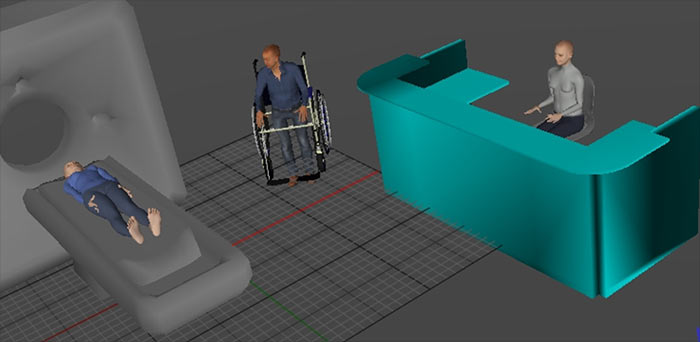
Easy Mannequin Positioning
- Completely articulated body within human ranges of motion
- Library of pre-defined mannequin body and hand postures. Users can add their own postures.
- Real-time Inverse kinematics (IK) and forward kinematics (FK)
- Capture postures that can be added to the Posture Library using Microsoft Kinect
- Mannequin reach point (can the mannequin or person reach the selected point)
- Mannequin see point (can the mannequin or person see the selected point)
- Digital floor with mannequin snap-to-floor feature
- Automated move which allows the user to move a mannequin to an object, or an object to an object
- Attach objects
Ergonomics and Space Analysis
- Reach-envelopes for hands and feet
- Mannequin's vision analysis with vision view windows, 3D representations for field of view, vision cones, and options for first person view from mannequin’s left eye, right eye or both.
- Basic 2D and 3D drawing/modeling tools including annotation and markup
- Dynamic distances and angles: Measurements are updated automatically when the 3D scene changes, for example as parts move or mannequins are resized
- Optional ErgoTools includes the revised NIOSH Lifting Equation and multiple biomechanical model options (including an interface to the University of Michigan 3D SSPP model, Energy Expenditure, OWAS, RULA, as well as Snook and Mital tables).
- BSIP (Body Segment Inertial Parameters) as defined by McConville et al. (1980) (on male US Air force soldiers) and Young et al. (1983) (on female US Air force soldiers). These methods elaborate more realistically segments' masses, centers of mass and matrices of inertia.

Versatile Environment and 3D Navigation
- Interactive Dragger: Allows easy repositioning of parts or mannequins
- The Properties View allows quick view and editing of all properties of selected parts, mannequins and measurements, including position and orientation, color
- The 3D renderer supports transparency and highlights and allows dynamic navigation through 3D scene
- OpenGL rendering
- Grouping of objects
- Multiple independent 3D views
- Quick and user-friendly manipulation of 3D objects
- The panels can be docked or floating, providing a more flexible interface
- The object hierarchy is graphically represented, with drag'n'drop support
- Transformable geometries are supported natively to simplify the user workflow
- User can import pictures or videos as background in the scene. Mannequins can then positioned to correspond to postures in the background image.
Extensive Import-Export Files Support
- File Import/Export support for DXF, FBX, OBJ, OSG, OSGB, OSGT, OSGX, IVE, and 3DS file formats included. IGES, STEP, STL and DWF (DWF file format only available for exporting) formats are available with the optional CADExchange module. The IGES v5.3 and STEP (AP203 and AP214) formats are supported.
- Files from MQP format need to be converted to OSG prior to being imported into HumanCAD
- Function to reload an imported CAD file which was modified in any CAD software allowing you to perform quicker human factor analysis of your 3D file
Ergonomic Design and Testing
HumanCAD can assist in the design of a variety of transportation vehicles. You can easily create mannequins of various anthropometries to test your designs for reach, vision and more.
HumanCAD digital human modeling technology is an important tool in determining the human fit of products and workplaces before they are built. This includes looking at comfort zones for certain tasks.
HumanCAD Modules
HumanCAD's plug-in architecture can support a variety of modules from NexGen. The following modules are currently available:
- Advanced Functions Set
- CADExchange
- ErgoTools
- Child Module
Recommended System Requirements
- Microsoft Windows 10 or 11
- Intel/AMD CPU, Core I5 or better
- 8GB+ of RAM (12-16GB+ if you are running CAD software at the same time, or multiple mannequins in HumanCAD)
- Good Graphics card or recent integrated video card
- 3-button mouse is recommended
- SSD drive is preferable but not mandatory
HumanCAD 15-Day Trial
Click here to register for a HumanCAD 15-day trial.
We will normally respond with your trial information within one business day.
NOTE: Software trials are provided for evaluation only prior to possible purchase by those involved in the evaluation and decision process. We also provide them to students when the university has purchased the software and the trial is coordinated thru academic staff.
Request a Quote
Please fill in the form below and click the Submit Request button to send us your quotation requirements. We will reply via email with pricing and delivery information.
Fields marked with an asterisk (*) are required.
Any contact information provided by visitors to our web site will be used solely for follow-up by NexGen Ergonomics Inc. and not distributed to any outside organization without prior permission.




